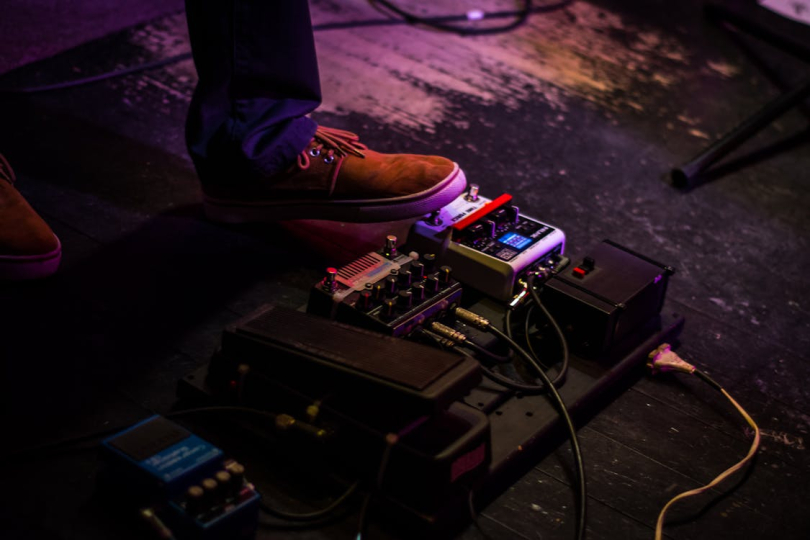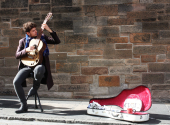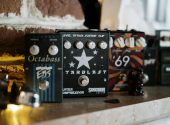
The Guitarist's Survival Guide: Getting Started with Effects Pedals (Part 1)
Guitar pedals are cool. That’s just a fact. They’re a fundamental part of the modern electric guitar scene. While bassists and keyboardists also make use of them, it’s fair to say pedals are usually found under the feet of a guitarist. Pedals are not only fun to use and collect; they also add to your unique sound, letting you build a collection that reflects your personal style. But, just like shopping for home studio equipment, there are a paralysing number of options. That’s why I’m here – to share some general advice, a few of my own insights, and to guide you through this exciting part of guitar playing.
Disclaimer: At this point, I’d like to make a few things clear.
- First, any recommendations I share come directly from my own experience—there’s no sponsorship or advertising involved.
- These tips can just as easily apply to musicians in other fields (such as bassists, keyboardists, violinists, etc.). I know all types of musicians who use pedals; it’s fun, and being creative or inspired is always a good thing.
- With that said, guitarists, perhaps more than any other musicians, are famously prone to GAS – Gear Acquisition Syndrome. Do try to remember the golden rule: playing the guitar is more important than the gear you collect to play it. If a pedalboard full of rare, boutique pedals is what gives you your kicks, well, more power to you. If you’re more about the down-to-earth simplicity of plugging straight into an amp, that’s just dandy too.
1. The Mighty Tuner
It’s a tuner. Plug into it and make sure you’re in tune. I know this piece is called "Getting Started with Effects" but I’m going to assume you have the basics down. Get a tuner.
Pro tip: If you’re jamming in your bedroom, a clip-on tuner will do the trick. But if you’re on stage, a tuner pedal can also serve as a mute switch – pretty useful! The sound of a guitarist tuning up on stage doesn’t exactly scream "professional".
Boss Tu-3
2. EQ Pedals
An EQ pedal lets you shape specific aspects of your tone, such as bass, mid and treble frequencies. It allows you to fine-tune your sound by boosting or cutting specific frequency bands.
Ok, so you think an EQ pedal isn’t sexy. It’s useful, is what it is, and pretty soon it will rock your socks off. Here are some applications (to name but a few!).
- Cut some bass frequencies from your guitar and stop clashing with your bassist. You’ll get a cleaner band sound, your bandmates will thank you, and anyway – we’re guitarists. We worship at the altar of the mid!
- Boost some mids, and you’ve got a handy solo boost to cut through the mix.
- Run it into a drive pedal and start experimenting – more mids, less bass and vice versa. The frequencies you send into your drive pedal will affect your tone quite drastically, so experiment! Hours of good, clean fun.
- Cut most of the frequency bands and max out the mids – who doesn’t love that "playing through a telephone" sound for the intro or bridge of a song?
- The lo-fi guitar effect, popular in lo-fi hip-hop and bedroom pop, mimics the sound of old cassette tapes. Use an EQ pedal to cut highs and shape your tone. Place it before dirt and compression pedals, boost the mids, and tweak the rest to create your unique lo-fi sound. Combine with a warble or vibrato pedal and you can make lo-fi beats to study all the livelong day.
- It’s possible to make a Humbucker Sound Like a Single-Coil (or Vice Versa). To get a single-coil sound from a humbucker guitar, use an EQ pedal placed before other effects. Cut frequencies below 200Hz and boost those above 3.2kHz for a jangly, low-output tone. To make a single-coil guitar sound like a humbucker, boost 200Hz, 400Hz, and 800Hz while cutting frequencies above 3.2kHz.
Source Audio EQ2
3. Other EQ Effects
Along with standard EQ pedals, I will mention two other forms of EQ-based effects.
Wah Pedal – Ah, the trusty wah. It’s like an EQ sweep where, with the toe down, the treble is up, and vice versa. It probably doesn’t need much explaining if you’ve ever heard the intro to "Voodoo Child" by Jimi Hendrix. Used with a clean tone, it’s great for funk. The Dunlop Cry Baby is probably the best-known model, not least because it was used by the aforementioned Mr. Hendrix.
Dunlop Crybaby
Envelope Filter – Imagine a wah pedal, but instead of adjusting the EQ with your foot, it reacts to how hard or soft you play. Louder notes emphasise the treble, while quieter ones bring out more bass. This results in notes starting with a bright, sharp tone that becomes fuller and bass-heavy as they decay, with louder notes staying bright and defined. This creates the classic 'quacking’ effect', which is especially popular in funk, particularly for bass guitar.
DOD Envelope Filter 440
4. Drive pedals
There are about a million different drive pedals on the market today, ranging in price, flavour, and gain level (from the respectable to the downright unreasonable). In terms of gain, think of overdrives as the kind of pedals you'd happily introduce to your parents, while fuzz pedals will pretend to like you, then steal your wallet when you’re not looking. Despicable. But, you know, there's just something about them.
Boost – This pedal simply makes your sound louder without altering your tone too much. It’s great for making lead melodies pop, or for pushing your amp a little harder to get some extra grit for solos. I like to use one for clean solos.
TC Electronic Spark Mini Booster
Overdrive – Adds a bit of grit to your tone, causing it to break up. Overdrive and Distortion are often confused, but overdrive tends to have less gain and is "lighter" than distortion. Famous examples include:
- The Tube Screamer (probably the most copied pedal ever) is synonymous with bluesy, saturated tones. Famous for its signature mid-range boost, it’s been a staple on countless pedalboards over the years. No surprises here, but hey – “If it ain’t broke...”
Ibanez TS9
- Transparent overdrives are an essential pedal for some and a marketing buzzword for others. Unlike the Tube Screamer, which has a noticeable mid bump, transparent overdrives aim to preserve your guitar's natural tone while adding gain. Famous examples include the "Bluesbreaker," "Klon," and their various clones.
Marshall Bluesbreaker
Distortion – A distortion pedal takes your guitar signal and pushes it to the next level, adding volume, crunch, and sustain to your sound. Thicker and more powerful than overdrive, distortion is a key ingredient in heavier genres like rock and metal, giving your tone that aggressive, saturated edge.
Boss DS1
Fuzz – These pedals offer a heavy and distorted sound with a very different flavour than that of a distortion pedal. A fuzz pedal radically alters your guitar signal, transforming it into a thick, fizzy, and often chaotic tone. Depending on the pedal, it can give you everything from a bass-heavy rumble to a spitting, 'broken' amp sound, making it one of the most extreme and expressive effects out there. Extremely fun to use. Definitely not suited to every situation!
Electro Harmonix Big Muff
5. Dynamic pedals
Compressor pedals may not wow you at first, but they’re incredibly useful. In essence, a compressor controls your dynamics – making louder notes quieter for a more consistent sound or extending the sustain of a note. It’s a must-have for country and funk, and a favourite among bassists for keeping every note clear and even. I love using one to aid my slide playing. It can be subtle and transparent (like smoothing out a clean rhythm guitar in a pop track), or drastically affect your tone (like the squashed transients in a funky slap bass or a country tune).
Origin Effects Cali 76
Volume pedals change the volume of your guitar! That should be obvious. So why use one instead of just turning the knob on your guitar? The foot motion combined with the pedal gives you a smooth, controlled sweep –perfect for those seamless swells. I use mine for slide or lap steel playing, where I swell into the note, removing the attack for a smoother sound. Stick it before a drive pedal, and it’ll clean up your tone.
Ernie Ball EB6180VP-JR Volume Pedal
That covers the first half of the pedals and effects I'll be discussing. In the next article, I'll dive into modulation and time-based effects. These are the ones most people consider the really "fun" effects, so be sure not to miss it!
If there's something you'd like me to cover, leave a comment suggesting a topic or asking a question, and I’ll do my darndest to get to it.
If you have found an error or typo in the article, please let us know by e-mail info@insounder.org.




